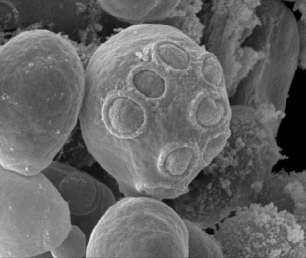Reproduction
Saccharomyces cerevisiae is fungal yeast, which is made up of DNA with 16 chromosomes and can reproduce asexually or sexually. There are also two forms of Saccharomyces cerevisiae, the diploid form and the haploid form. When the environment is favorable the diploid form reproduces asexually via mitosis (budding) and then continues to grow and eventually will die. If the environment seems to be unfavorable the cell can choose to under go sporulation. Sporulation is when the cell undergoes meiosis, resulting in a large amount of haploid spores. These haploid spores then go on to mate. When the yeast is found in diploid cell form, it reproduces asexually via mitosis, then grows and eventually will die. (Probiotic 2009) When the environment unfavorable in the haploid case, the cell doesn’t have a back up plan and just ends up going through the life cycle much quicker. (Detailed diagram bellow.)
The haploid (n) form is most often only found in labs and the diploid (2n) form is found everywhere else, with the exception of brewing which is where the aneuploidy (3n) form is found. (Bamforth 2003) The aneuploidy form is considered to be the most stable form because it has three copies off its DNA so if one is lost there is still two other copies.
Continue reading about its interactions or return to homepage.


